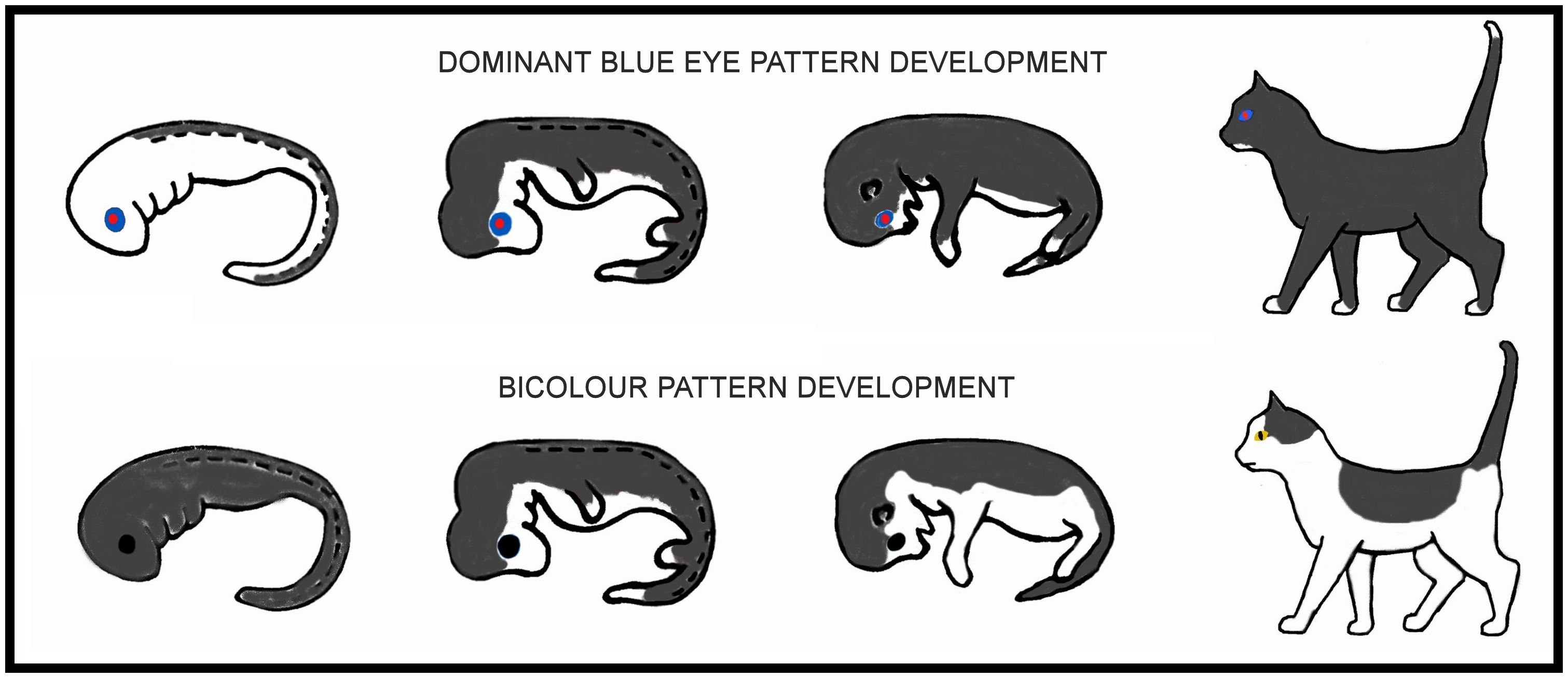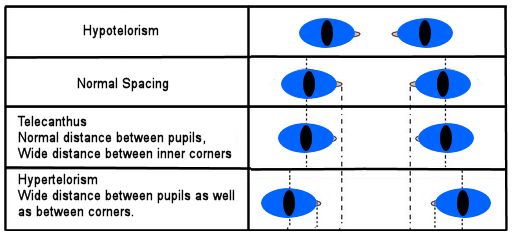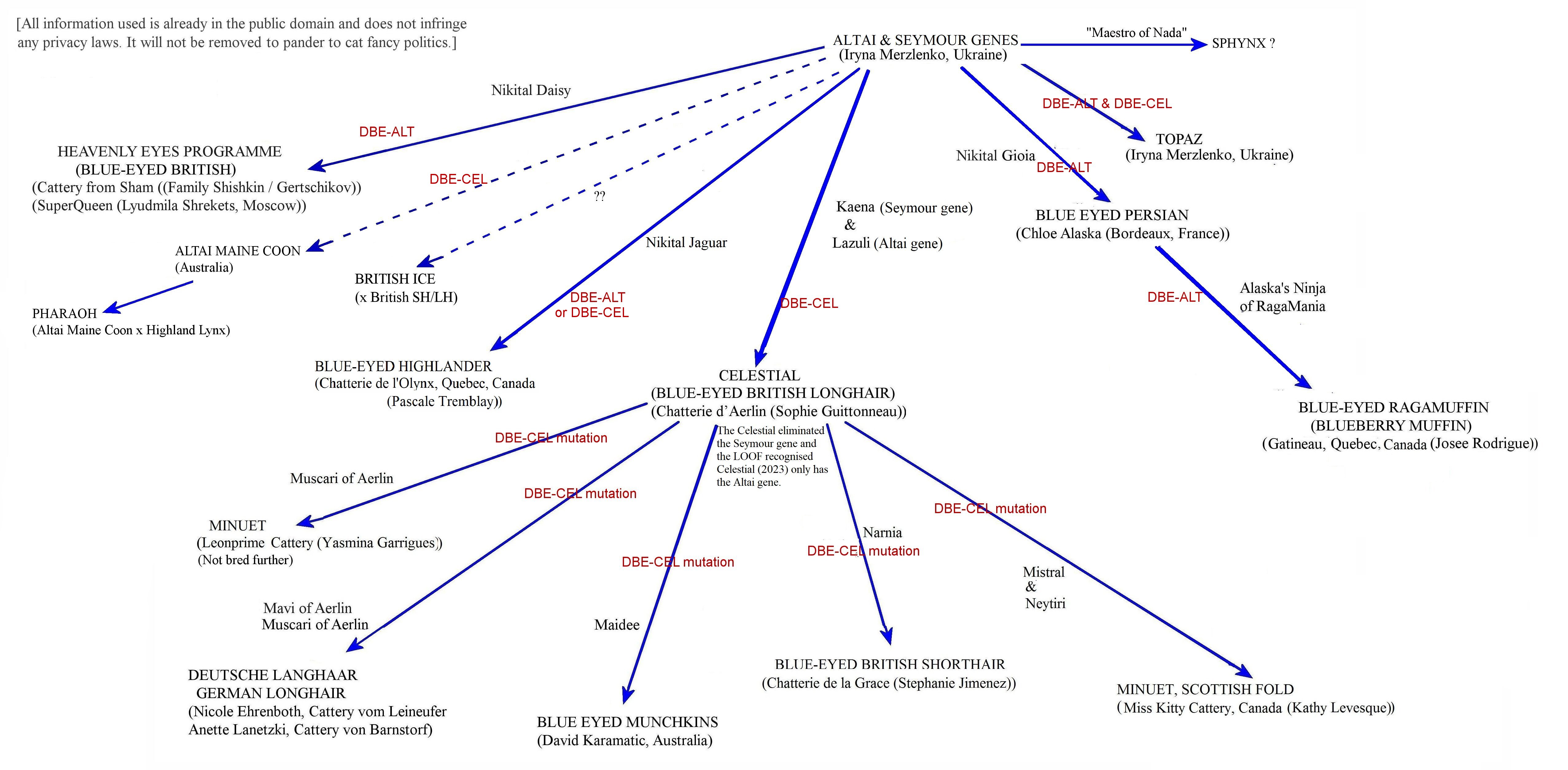
DOMINANT BLUE EYES AND WAARDENBURG SYNDROME
There are various genes involved in white spotting and in blue-eyes. The best known are the KIT gene mutations which cause various forms of white spotting, bicolour and solid white in cats. In 2024, Marie Aibtbol et al identified PAX3 gene mutations as the cause of the Dominant Blue Eyes trait. In humans, a PAX3 mutation is associated with Waardenburg syndrome. Not all PAX3 mutations are the same and the effects depend on the type of mutation. Because Waardenburg syndrome is associated with white markings and blue eyes, some researchers also class KIT gene mutations as part of the Waardenburg Syndrome (WS) group. If KIT mutations are classed as types of Waardenburg syndrome, complete with potential deafness, then all bicolour cats and all solid white cats are Waardenburg Syndrome cats!
Currently the mutations involved in the various "dominant blue eye" (DBE) mutations are not fully identified and catalogued, but they are known to be forms of white spotting. In some DBE mutations there is a distinctive pattern of white marking e.g. white tail tip with white toes, white forequarters and coloured hindquarters. In others, the white spotting is localised to the eyes; the eyes are part of the embryo surface so absence of melanin at that location of the skin surface gives rise to blue eyes.
In 2024 Marie Abitbol in France identified at least one mutation behind DBE (in the Celestial breed). In 2023 she isolated mutations for 2 DBE lines (Roxi's and Seymour's lines); these mutations are not in exactly the same area. The "Roxi" gene is a PAX3 mutation named DBECEL. For a 3rd line of DBE cats, the gene is completely different. This is why the different mutations should not be bred together. The different markings seen in breeding lines developed from different foundation cats indicates there are different mutations of the gene. Breeders in Russia and Ukraine have worked out that the different mutations should not be bred together as this increases the chance of side-effects such as deafness, black/very dark irises and premature greying.
- DBE has occurred spontaneously in unrelated cats in multiple countries hence there are likely to be a variety of mutations and they should not all be lumped into the Waardenburg Type 2A category until the different mutations are identified.
- Until the different mutations are identified, when working with DBE work only with one mutation imported from one existing blue-eyed breed. Do not mix mutations from different foundation cats.
In solid white and high white cats there is a known link to deafness because melanin is involved in the development of the inner ear (the part that detects sound vibrations) as well as the pigmentation of the skin and fur. BAER testing (acoustically evoked brain stem responses) is used by many European breeders to ensure that they don't deliberately breed deaf cats. The prevalence of deafness and partial hearing in an experimental colony of white cats was 67% (deaf - 0.55 coefficient of heritability) and 29% (partial hearing - 0.75 coefficient of heritability) which suggests a pleiotropic major gene (a gene that has 2 seemingly unrelated traits) and the likelihood of polygenes.
- Geigy CA, Heid S, Steffen F, Danielson K, Jaggy A, Gaillard C (2007). "Does a pleiotropic gene explain deafness and blue irises in white cats?". Veterinary Journal. 173 (3): 548 553. PMID 16956778.
This was commented upon by Strain GM, in "Deafness in blue-eyed white cats: the uphill road to solving polygenic disorders."Vet J. 2007 May;173(3):471-2. Epub 2007 Feb 21.

In bicolour cats, pigment stops migrating as the embryo grows, giving rise to relatively large white areas. In DBE cats, the pigment continues to migrate as the embryo grows so that only small areas of white remain toes, tail-tip, lips if at all.
ALARMISM ABOUT WAARDENBURG SYNDROME
SYNDROME DOES NOT MEAN DISEASE. A syndrome is a collection of traits that consistently occur together. "Syndrome" does not mean "disease." Because the medical profession is primarily concerned with those that need medical care the word "syndrome" has gained a negative connotation.
In FIFe, there is much alarmism about DBE = Waardenburg = severe health issues. Only Waardenburg types 3 and 4 are associated with severe problems. FIFe have associated DBE cats with Waardenburg syndrome subtype 2A; this is based on physical resemblance to human Type 2A as the feline mutations have not yet been identified. Waardenburg syndrome Type 2A has no deleterious effects apart from deafness, however, European Companion Animal legislation has ruled that deaf cats must not be purposely bred.
Forms of human Waardenburg syndrome are caused by mutations in EDN3, MITF, PAX3, SNAI2, and SOX10. Type 2E (a SOX10 mutation) can additionally cause developmental delay and behavioural issues. Mouse mutants for these genes have similar but not identical phenotypes. This implies that cats with similar phenotypes may not have the same gene mutations as the human or mouse models for each Type.
Type 1 Waardenburg
Symptoms include some (not necessarily all) of the following - wide-set eyes, heterochromia or pale blue eyes, white forelock/unusual hair pigmentation, white patches on the hair and skin, broad nasal bridge, incomplete nostril development, premature greying, deafness caused by problems of the inner ear. Caused by a mutation of the PAX 3 gene.
In most cases, Waardenburg syndrome type 1 is inherited as autosomal dominant traits with variable penetrance and expressivity.
Type 2 Waardenburg
As for type 1, except the eyes aren t wide-set. A mutation in genes other than those currently identified may cause a Waardenburg syndrome with features of type 2. These may be given their own subtypes once a gene or locus is identified. Caused by a mutation in the MITF or SOX10 gene.
In humans homozygous for a particular MITF mutation, additional symptoms are a hole in the iris (coloboma), small eyes (microphthalmia), hardened bones (osteopetrosis), macrocephaly, albinism and deafness. Apart from deafness, these have not been observed in known lines of DBE cats.
In most cases, Waardenburg syndrome type 2 is inherited as autosomal dominant traits with variable penetrance and expressivity.
Type 2A Waardenburg
As for type 2, without telecanthus (abnormality of inner corner of eye(s)).
DBE cats resemble this form, but the feline mutation has not yet been identified. As with the more usual white spotting/masking gene, blue-eyed cats with a high degree of white on the face may exhibit deafness.
Type 3 Waardenburg
NOT PRESENT IN DBE CATS. (Klein-Waardenburg syndrome) like Type 2 + abnormalities of the hands e.g. fused fingers, and of the arms. Caused by a mutation of the PAX 3 gene.
Type 4 Waardenburg
NOT PRESENT IN DBE CATS. (Waardenburg-Shah syndrome) like Type 2 + missing nerve cells in the large intestine causing frequent constipation. Caused by mutation of the EDNRB, EDN3 or SOX10.
A mutation in the EDNRB gene has been found to cause Waardenburg syndrome in horses.
- Hauswirth R, Haase B, Blatter M, et al. Mutations in MITF and PAX3 cause "splashed white" and other white spotting phenotypes in horses [published correction appears in PLoS Genet. 2019 Aug 2;15(8):e1008321]. PLoS Genet. 2012;8(4):e1002653.
- Pingault V, Ente D, Dastot-Le Moal F, Goossens M, Marlin S, et al. Review and update of mutations causing Waardenburg syndrome. Hum Mutat. 2010;31:391 406
- Tachibana M, Kobayashi Y, Matsushima Y. Mouse models for four types of Waardenburg syndrome. Pigment Cell Res. 2003;16:448 454

UNIDENTIFIED WAARDENBURG MUTATIONS (FERRETS, CATS)
The gene mutation associated with WS in ferrets has not yet been identified. These have mild WS but show a high incidence of deafness due to selective breeding for desirable white facial markings.
In cats the traits occurring together can include: distinctive distribution of white, premature greying, brilliant blue eye-colour in one or both eyes, or eyes where the iris has two different colours (sectoral heterochromia), congenital deafness, broader nose and shortened tail. Apart from deafness, which is seen in blue-eyed white cats, these traits are cosmetic and have less impact than (for example) skeletal problems in Scottish Folds or spinal problems in Manx, both of which are managed by careful selective breeding.
FELINE DOMINANT BLUE EYE IS NOT THE SAME AS DOG "MERLE."
Despite some similarities in appearance, cat DBE is not the same as dog merle. Merle in dogs is an autosomal, incomplete dominant mutation in the region of CFA10 that contains the SILV (aka PMEL) gene causing mosaic fur and blue or odd eyes. Merle dogs inherit a range of hearing and visual abnormalities similar to human Waardenburg syndrome. The merle gene can vary in size (DNA repeats), with the pattern and effects depending on the size of the merle gene, and different cells can have different size merle genes. Homozygous merle is linked to blindness or other severe eye abnormalities. Merle dogs have a high degree of white, hence the gene is also called "lethal white."
BULK BREEDERS / KITTEN MILLS / BACK-YARD BREEDERS
The interest in DBE has led to several blue-eyed breeds being developed by reputable breeders. Some are introducing blue eyes into existing breeds (but under a new breed name) while others are working only with blue-eyed cats from the random-bred gene pool. These breeders keep records of any abnormalities they encounter, they neuter cats that have any form of abnormality (to prevent it being passed on) and they avoid mixing genes from different sources.
The downside of the sudden popularity of DBE traits is that bulk breeders do not care which genes they are working with, they simply want to churn out blue-eyed cats to sell to cat lovers regardless of any health issues caused by mixing mutations. This uncontrolled breeding means all DBE breeds come under suspicion and there are unfounded fears of debilitating forms of Waardenburg syndrome in all blue-eye breeds.
DO NOT MIX DIFFERENT MUTATIONS TOGETHER
At present all the DBE breeds descended from Russian/Ukrainian cats have the Altai gene only. When DBE was discovered in Kazakhstan (Altai gene) it was used for the foundation of the Topaz breed and mixed with a DBE cat from 3,000 km away in Russia. The 2 genes used in the Topaz were not compatible and the breeding lines that produced kittens with premature greying panda pattern, or black eyes were sterilised. Only the Altai gene was perpetuated and only the Altai gene (ABE Altai Blue Eyes) has been exported to Europe, North America and Australasia. Other blue-eye genes have been separately bred in Russia and Ukraine, but not exported or used in any DBE breeds.

Spontaneous DBE mutations occurred in Joyfield Maine Coons and in Ermine Trace chinchilla British Shorthairs. These have not been added into Altai-derived DBE breeding programmes. Altai Maine Coons have been bred in Australia. Canadian breeders working with the Joyfield strain of DBE Maine Coons plans to add Altai Maine Coons (from Russia/Ukraine) to the breeding programme to improve eye-colour. This ignores lessons learnt from mixing two unrelated DBE genes in the early days of the Topaz breed the combination that raised the Waardenburg Syndrome scare in the first place.
In 2023 Marie Abitbol isolated mutations on one chromosome for 2 of the DBE lines (Roxi's and Seymour's); these mutations are not in exactly the same area. For a 3rd line of DBE cats, the gene is completely different. Because the DBE mutations affect different parts of the KIT gene they should not be bred together. Tests will be developed for the genes identified so far.
Until you are able to test outcross cat(s) and they have the same DBE mutation as your current DBE lines, do not breed them together. Instead of improving eye colour you risk potentially serious problems in the descendants and risk ruining your breeding programme.
RECORD ABNORMALITIES
Reputable breeders take health issues seriously and maintain breeding records. They record abnormalities and sterilise affected breeding lines even if they do not discuss them with the wider public. Iryna Merzlenko was gracious enough to share information highlighting the dangers of mixing unrelated DBE genes. Backyard breeders will use local randombred cats with spontaneous DBE mutations and mix them together with no regard for health or record-keeping.